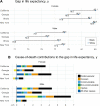Black and White Differences in Life Expectancy in 4 US States, 1969-2013
- PMID: 31600482
- PMCID: PMC6832087
- DOI: 10.1177/0033354919878158
Black and White Differences in Life Expectancy in 4 US States, 1969-2013
Abstract
Objectives: Racial differences in mortality in the United States have narrowed and vary by time and place. The objectives of our study were to (1) examine the gap in life expectancy between white and black persons (hereinafter, racial gap in life expectancy) in 4 states (California, Georgia, Illinois, and New York) and (2) estimate trends in the contribution of major causes of death (CODs) to the racial gap in life expectancy by age group.
Methods: We extracted data on the number of deaths and population sizes for 1969-2013 by state, sex, race, age group, and 6 major CODs. We used a Bayesian time-series model to smooth and impute mortality rates and decomposition methods to estimate trends in sex- and age-specific contributions of CODs to the racial gap in life expectancy.
Results: The racial gap in life expectancy at birth decreased in all 4 states, especially among men in New York (from 8.8 to 1.1 years) and women in Georgia (from 8.0 to 1.7 years). Although few deaths occurred among persons aged 1-39, racial differences in mortality at these ages (mostly from injuries and infant mortality) contributed to the racial gap in life expectancy, especially among men in California (1.0 year of the 4.3-year difference in 2013) and Illinois (1.9 years of the 6.7-year difference in 2013). Cardiovascular deaths contributed most to the racial gap in life expectancy for adults aged 40-64, but contributions decreased among women aged 40-64, especially in Georgia (from 2.8 to 0.5 years). The contribution of cancer deaths to inequality increased in California and Illinois, whereas New York had the greatest reductions in inequality attributable to cancer deaths (from 0.6 to 0.2 years among men and from 0.2 to 0 years among women).
Conclusions: Future research should identify policy innovations and economic changes at the state level to better understand New York's success, which may help other states emulate its performance.
Keywords: inequality; mortality; race.
Conflict of interest statement
Figures




References
-
- Harper S, MacLehose RF, Kaufman JS. Trends in the black-white life expectancy gap among US states, 1990-2009. Health Aff (Millwood). 2014;33(8):1375–1382. doi:10.1377/hlthaff.2013.1273 - PubMed
-
- Benjamins MR, Hirschtick JL, Hunt BR, Hughes MM, Hunter B. Racial disparities in heart disease mortality in the 50 largest U.S. cities. J Racial Ethn Health Disparities. 2017;4(5):967–975. doi:10.1007/s40615-016-0300-6 - PubMed
MeSH terms
LinkOut - more resources
Full Text Sources
Miscellaneous

